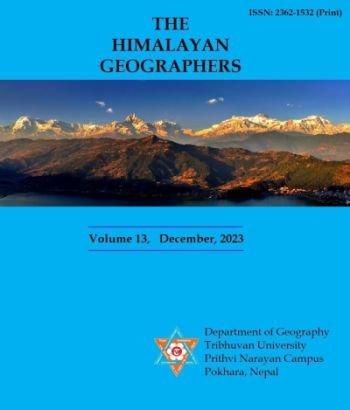Comparative Analysis of Urban Area Extraction Using Different Classification Methods: A Case Study of Ghorahi Sub-Metropolitan City, Nepal
DOI:
https://doi.org/10.3126/thg.v13i1.71342Keywords:
Landuse Land Cover, Urban Growth, Satellite Image, RS/GIS, Supervised Maximum Livelihood, GhorahiAbstract
Rapid urban area expansion is taking place Ghorahi Sub-Metropolis City in the last ten years. But there is no detailed analysis carried yet. This study focuses on analyzing the urbanization and LULC changes by adopting different classification techniques in the multispectral remote sensing imagery. For this propose, Landsat OLI data of 2013, 2016 and 2020 have been downloaded from USGS site and analyzed. Four algorithms are compared in this paper to reach the most accurate technique for urban area extraction: namely, supervised maximum-likelihood (SML), Indices-based SML, Support Vector Machine (SVM) classifiers, and Indices-based SVM classifiers. The results shows that the Indices-based SVM classifier had the maximum classification accuracy for LULC maps pertaining to 2013, 2016, and 2020. The accuracy assessments were performed which further established the results and showed notable changes: agricultural land decreased by 13.75%, barren land increased by 297.21%, and the built-up area increased by 82.09% from 2013 to 2020. This rapid growth of urban areas necessitates the adoption of sustainable land-use policies, zoning laws, and measures for preventing the conversion of agricultural land to other land uses. These changes need to be unwrapped for mitigating the environmental and social consequences of growth in Ghorahi Sub-metropolitan City.
Downloads
Downloads
Published
How to Cite
Issue
Section
License
Copyright (c) 2023 The Author(s)

This work is licensed under a Creative Commons Attribution-NonCommercial 4.0 International License.
This license enables reusers to distribute, remix, adapt, and build upon the material in any medium or format for noncommercial purposes only, and only so long as attribution is given to the creator.




